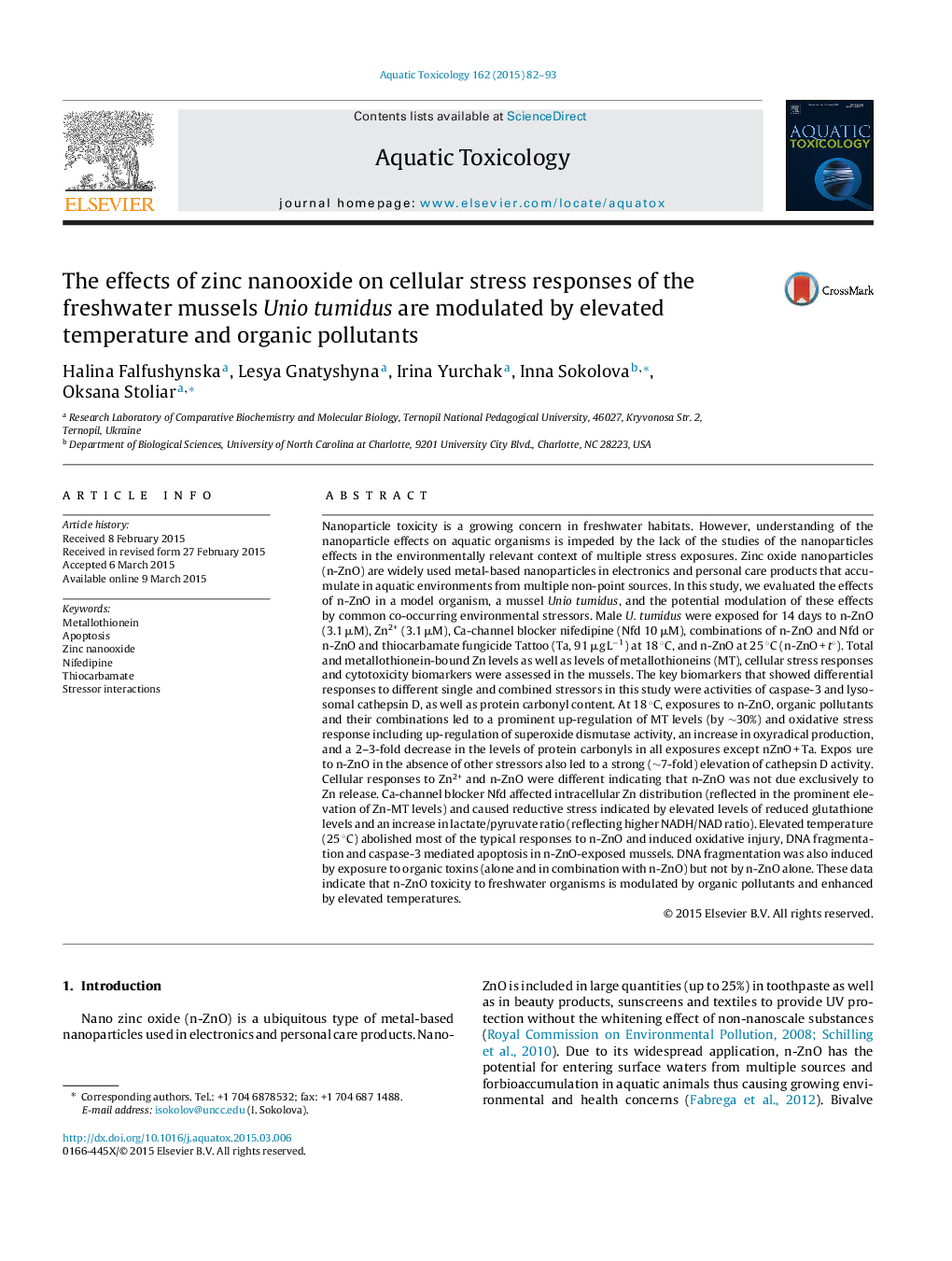| کد مقاله | کد نشریه | سال انتشار | مقاله انگلیسی | نسخه تمام متن |
|---|---|---|---|---|
| 4529107 | 1625943 | 2015 | 12 صفحه PDF | دانلود رایگان |

• Effects of nano-ZnO (n-ZnO) in combination with other stressors were studied.
• At 18 °C, exposures to n-ZnO caused up-regulation of lysosomal cathepsin D.
• Cellular responses to n-ZnO and Zn2+ were distinct.
• Warming to 25 °C activated caspase-3 and abolished antioxidants response to n-ZnO.
• Biological effects of n-ZnO in mussels are strongly modulated by other stressors.
Nanoparticle toxicity is a growing concern in freshwater habitats. However, understanding of the nanoparticle effects on aquatic organisms is impeded by the lack of the studies of the nanoparticles effects in the environmentally relevant context of multiple stress exposures. Zinc oxide nanoparticles (n-ZnO) are widely used metal-based nanoparticles in electronics and personal care products that accumulate in aquatic environments from multiple non-point sources. In this study, we evaluated the effects of n-ZnO in a model organism, a mussel Unio tumidus, and the potential modulation of these effects by common co-occurring environmental stressors. Male U. tumidus were exposed for 14 days to n-ZnO (3.1 μM), Zn2+ (3.1 μM), Ca-channel blocker nifedipine (Nfd 10 μM), combinations of n-ZnO and Nfd or n-ZnO and thiocarbamate fungicide Tattoo (Ta, 91 μg L−1) at 18 °C, and n-ZnO at 25 °C (n-ZnO + t°). Total and metallothionein-bound Zn levels as well as levels of metallothioneins (MT), cellular stress responses and cytotoxicity biomarkers were assessed in the mussels. The key biomarkers that showed differential responses to different single and combined stressors in this study were activities of caspase-3 and lysosomal cathepsin D, as well as protein carbonyl content. At 18 °C, exposures to n-ZnO, organic pollutants and their combinations led to a prominent up-regulation of MT levels (by ∼30%) and oxidative stress response including up-regulation of superoxide dismutase activity, an increase in oxyradical production, and a 2–3-fold decrease in the levels of protein carbonyls in all exposures except nZnO + Ta. Expos ure to n-ZnO in the absence of other stressors also led to a strong (∼7-fold) elevation of cathepsin D activity. Cellular responses to Zn2+ and n-ZnO were different indicating that n-ZnO was not due exclusively to Zn release. Ca-channel blocker Nfd affected intracellular Zn distribution (reflected in the prominent elevation of Zn-MT levels) and caused reductive stress indicated by elevated levels of reduced glutathione levels and an increase in lactate/pyruvate ratio (reflecting higher NADH/NAD ratio). Elevated temperature (25 °C) abolished most of the typical responses to n-ZnO and induced oxidative injury, DNA fragmentation and caspase-3 mediated apoptosis in n-ZnO-exposed mussels. DNA fragmentation was also induced by exposure to organic toxins (alone and in combination with n-ZnO) but not by n-ZnO alone. These data indicate that n-ZnO toxicity to freshwater organisms is modulated by organic pollutants and enhanced by elevated temperatures.
Journal: Aquatic Toxicology - Volume 162, May 2015, Pages 82–93